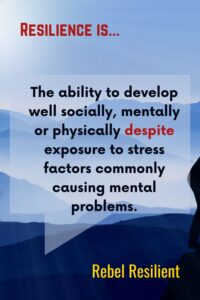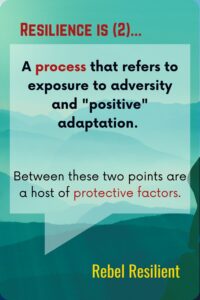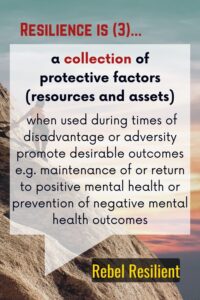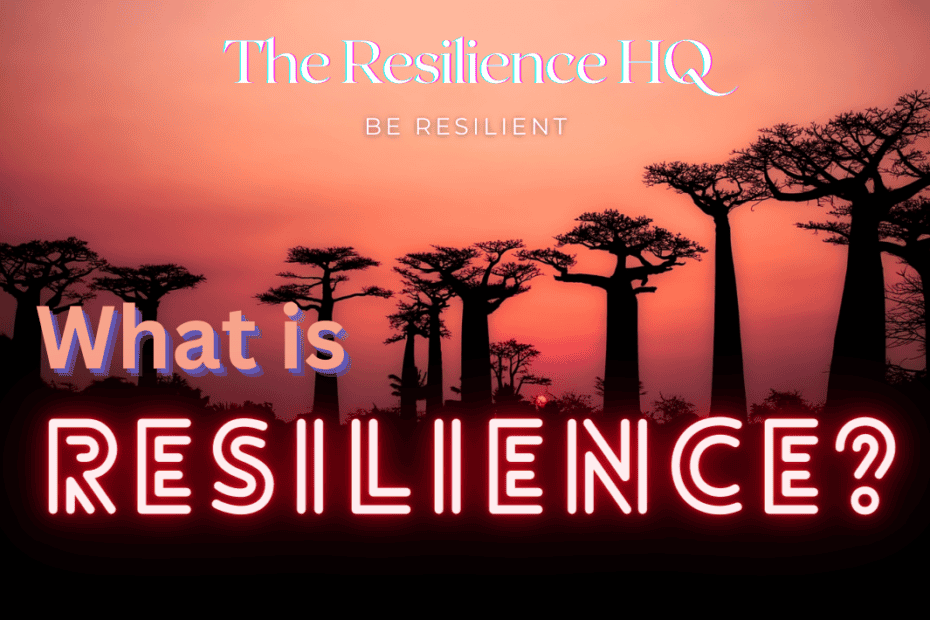What is resilience definition? There are many ways it is described. Is it a trait that we are born with or can resilience be learned? We come across many confusing and overlapping concepts that people relate to resilience. Some of these may be incorrect but nevertheless, related to resilience. Here are some of the definitions from research in child psychiatry to help you understand this concept.
Resilience Definition 1: Ability to develop well despite stress

“The ability to develop well socially, mentally or physically despite exposure to stress factors commonly causing mental problems. The view of resilience has changed from that of a static, innate capacity, to that of an acquired ability that is situational and changeable over time.” (Ref 1)
Resilience is therefore not something we are either born with or not, and it is not static. We can learn it to increase our resilience.
Resilience Definition 2: Is it a trait or can it be learned?

“Resilience is not just a personality trait or attribute of an individual. Rather, resilience is most often viewed as a process that refers to exposure to adversity and “positive” adaptation. Between these two points are a host of protective factors such as family, school, community and society that appear to modify vulnerability to the effects of adversity.” (Ref 2)
We must understand that resilience is not a personality trait. It can be learnt, taught, developed and improved for ourselves or others. We cannot think of resilience in a vacuum but rather, in pair with adversities and vulnerabilities. When we develop this view of resilience, we realise that there are a host of factors that can protect individuals against these adversities. These are protective factors that reduce or prevent the negative impact of adversities on an individual. These can be things an individual does alone for themselves, support from family, interventions from school, community and society.
Resilience can therefore come not only just from an individual exposed to adversity but also from other people and institutions around them. This is extremely useful as children or adults may not (yet) have the necessary skills to overcome difficulties but others around them can help them develop “positive” adaptation to adversities they are facing.
Think about children whose parents are going through divorce.
Think about children and adults facing bereavement.
Consider bullying, social problems like crime, poverty etc.
The application of resilience concept has the potential to transform our life and of those around us.
Resilience Definition 3: Collection of protective factors

“Resilience is a collection of protective factors (resources and assets) that when strengthened and employed by an individual during times of disadvantage or adversity promote desirable outcomes such as the maintenance of or return to positive mental health or prevention of negative mental health outcomes.” (Ref 3)
“Studies have found high levels of protective factors, such as personal and social competence, perceived level of family cohesion, and social reosurces, to be associated with positive mental health outcomes such as reduced symptoms or levels of depression, anxiety, stress and obsessive compulsive disorder in adolescents.” (Ref 3)
Resilience can therefore not only prevent mental health and other problems but also help us reduce or overcome them, if we do have to face them. Again, the importance of considering personal and social competence, family and social reosurces cannot be overstated.
Resilience is…
- A process
- Multidimensional concept
- A continuum
- Develops in responce to challenges, not in their absence
- Person (or systems) become stronger than before
Resilience is not…
- An attribute
- A personality trait
- A single event
- A binary outcome
References
- Agnafors, et al; A biopsychosocial approach to risk and resilience on behaviour in children followed from birth to age 12. Child Psychaitry Hum Dev. DOI 10.1007/s10578-016-0684-x.
- Nazilla Khanlou, Ron Wray; Int Ment Health Addiction (2014) 12:64-79.
- Julia Dray, et al; Systematic Reviews (2015)4:186.

Pingback: Be Resourceful: Discover 9 Ways To Elevate Your Potential - The Resilience HQ
Pingback: Learn to Recognise Signs of Mental Health Issues at University - The Resilience HQ
Pingback: Soil and Soul: Cultivating Resilience Through Nature and Inner Strength - The Resilience HQ